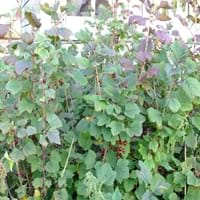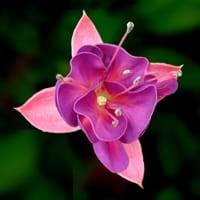Life Span
Not Available
Perennial
Type
Fruit
Tender Perennial
Origin
Not Available
Caribbean
Types
Not Available
Fuchsia Decidua, Fuchsia Fulgens, Fuchsia Splendens, Fuchsia Microphylla
Number of Varieties
Not Available
Habitat
Clay soil areas, Loamy soils, Sandy areas, Well Drained
Forest edges, Woods
USDA Hardiness Zone
5-9
9-10
Sunset Zone
A1, A2, A3, 1a, 1b, 2a, 2b, 3a, 3b, 4, 5, 6, 7
16, 17, 23, 24
Habit
Upright/Erect
Arching/Fountain-shaped
Flower Color
Green, Purple
Orange Red
Flower Color Modifier
Bicolor
Not Available
Fruit Color
Red, Purple, Burgundy, Black
Not Available
Leaf Color in Spring
Green
Purple, Dark Green
Leaf Color in Summer
Green
Purple, Dark Green
Leaf Color in Fall
Green
Purple, Dark Green
Leaf Color in Winter
Light Green
Unknown
Leaf Shape
Palmate
Long Linear
Plant Season
Summer, Fall
Spring, Summer, Fall, Winter
Sunlight
Full Sun, Partial Sun, Partial shade
Full Sun, Partial Sun, Partial shade
Growth Rate
Medium
Medium
Type of Soil
Clay, Loam, Sand
Clay, Loam, Sand
The pH of Soil
Acidic, Neutral, Alkaline
Acidic, Neutral
Soil Drainage
Well drained
Average
Bloom Time
Spring
Indeterminate
Tolerances
Drought
Drought
Where to Plant?
Ground
Container, Ground, Pot
How to Plant?
Budding, Seedlings, Stem Cutting
Seedlings, Stem Planting, Transplanting
Plant Maintenance
Medium
Medium
Watering Requirements
Allow to dry out slightly between watering, Do not water frequently
Requires regular watering
In Summer
Lots of watering
Lots of watering
In Spring
Moderate
Moderate
In Winter
Average Water
Average Water
Soil pH
Acidic, Neutral, Alkaline
Acidic, Neutral
Soil Type
Clay, Loam, Sand
Clay, Loam, Sand
Soil Drainage Capacity
Well drained
Average
Sun Exposure
Full Sun, Partial Sun, Partial shade
Full Sun, Partial Sun, Partial shade
Pruning
Do not prune during shooting season, Remove damaged leaves, Remove dead branches, Remove dead leaves, Thinning
Prune in spring, Prune lower leaves, Remove dead or diseased plant parts, Remove deadheads, Remove shoots
Fertilizers
Apply N-P-K, since leafy plants, use higher nitrogen content fertilizer
All-Purpose Liquid Fertilizer
Pests and Diseases
Birds, Leaf spot, Red blotch
Rhizoctonia Root Rot, Rust
Plant Tolerance
Drought
Drought
Flowers
Insignificant
Yes
Flower Petal Number
Single
Single
Foliage Texture
Medium
Medium
Foliage Sheen
Glossy
Matte
Attracts
Birds
Hummingbirds
Allergy
Not Available
Asthma, Hay fever
Aesthetic Uses
Cottage Garden
Showy Purposes
Beauty Benefits
Not Available
Not Available
Environmental Uses
Air purification
Air purification
Medicinal Uses
Not Available
Not Available
Part of Plant Used
Fruits
Flowers, Fruits
Other Uses
Used As Food
Not Available
Used As Indoor Plant
No
Yes
Used As Outdoor Plant
Yes
Yes
Garden Design
Edible, Fruit / Fruit Tree, Hedges, Mixed Border
Bedding Plant, Container, Feature Plant, Foundation, Hedges, Tropical
Botanical Name
RIBES x culverwellii
FUCHSIA triphylla
Common Name
Jostaberry
Fuchsia
In Hindi
Jostaberry
फ्यूशिया
In German
Jostaberry
Fuchsie
In French
casseille
Fuchsia
In Spanish
Jostaberry
Fucsia
In Greek
Jostaberry
φουξία
In Portuguese
Jostaberry
Fúcsia
In Polish
Jostaberry
Fuksja
Phylum
Magnoliophyta
Magnoliophyta
Class
Equisetopsida
Dicotyledonae
Order
Saxifragales
Myrtales
Family
Grossulariaceae
Onagraceae
Clade
Angiosperms, Core eudicots, Eudicots
Angiosperms, Eudicots, Rosids
Tribe
Not Available
Not Available
Subfamily
Not Available
Not Available
Difference Between Jostaberry and Fuchsia
If you are confused whether Jostaberry or Fuchsia are same, here are some features about those plants to help you choose better. Many people think that these two plants have the same characteristics, but one can see Jostaberry and Fuchsia Information and learn more about it. Fertilizers required for proper growth of Jostaberry are Apply N-P-K and since leafy plants, use higher nitrogen content fertilizer, whereas for Fuchsia fertilizers required are All-Purpose Liquid Fertilizer. Hence, one should know the basic difference between Jostaberry and Fuchsia if you are planning to have them in your garden to enhance its beauty.
<
Flowering PlantsImportance of Jostaberry and Fuchsia
Want to have the most appropriate plant for your garden? You might want to know the importance of Jostaberry and Fuchsia. Basically, these two plants vary in many aspects. Compare Jostaberry and Fuchsia as they differ in many characteristics such as their life, care, benefits, facts, etc. Every gardener must at least have the slightest clue about the plants he wants to plant in his garden. Compare their benefits, which differ in many ways like facts and uses. The medicinal use of Jostaberry is Not Available whereas of Fuchsia is Not Available. Jostaberry has beauty benefits as follows: Not Available while Fuchsia has beauty benefits as follows: Not Available.
Compare Facts of Jostaberry vs Fuchsia
How to choose the best garden plant for your garden depending upon its facts? Here garden plant comparison will help you to solve this query. Compare the facts of Jostaberry vs Fuchsia and know which one to choose. As garden plants have benefits and other uses, allergy is also a major drawback of plants for some people. Allergic reactions of Jostaberry are Not Available whereas of Fuchsia have Asthma and Hay fever respectively. Having a fruit bearing plant in your garden can be a plus point of your garden. Jostaberry has showy fruits and Fuchsia has no showy fruits. Also Jostaberry is not flowering and Fuchsia is flowering. You can compare Jostaberry and Fuchsia facts and facts of other plants too.





